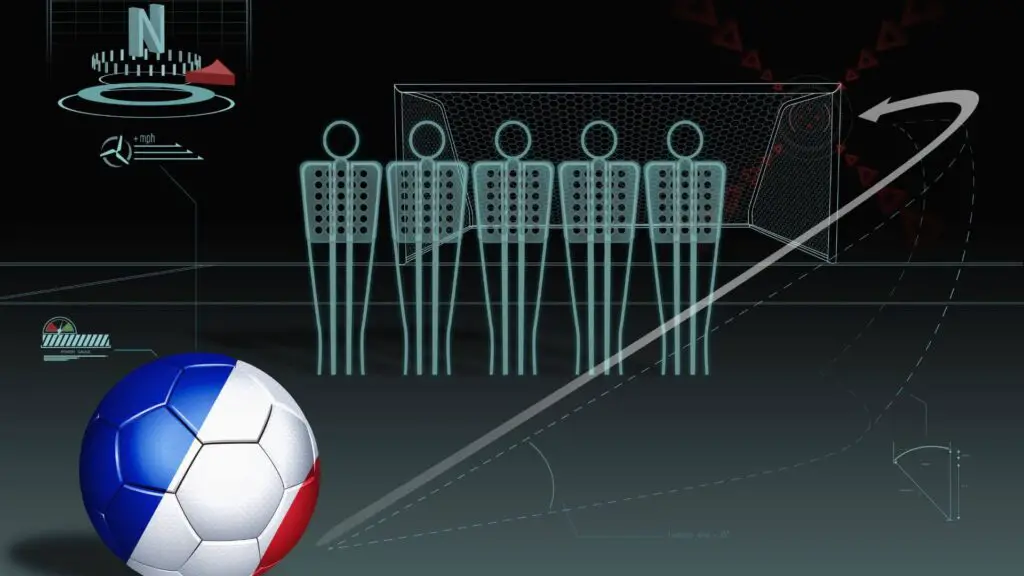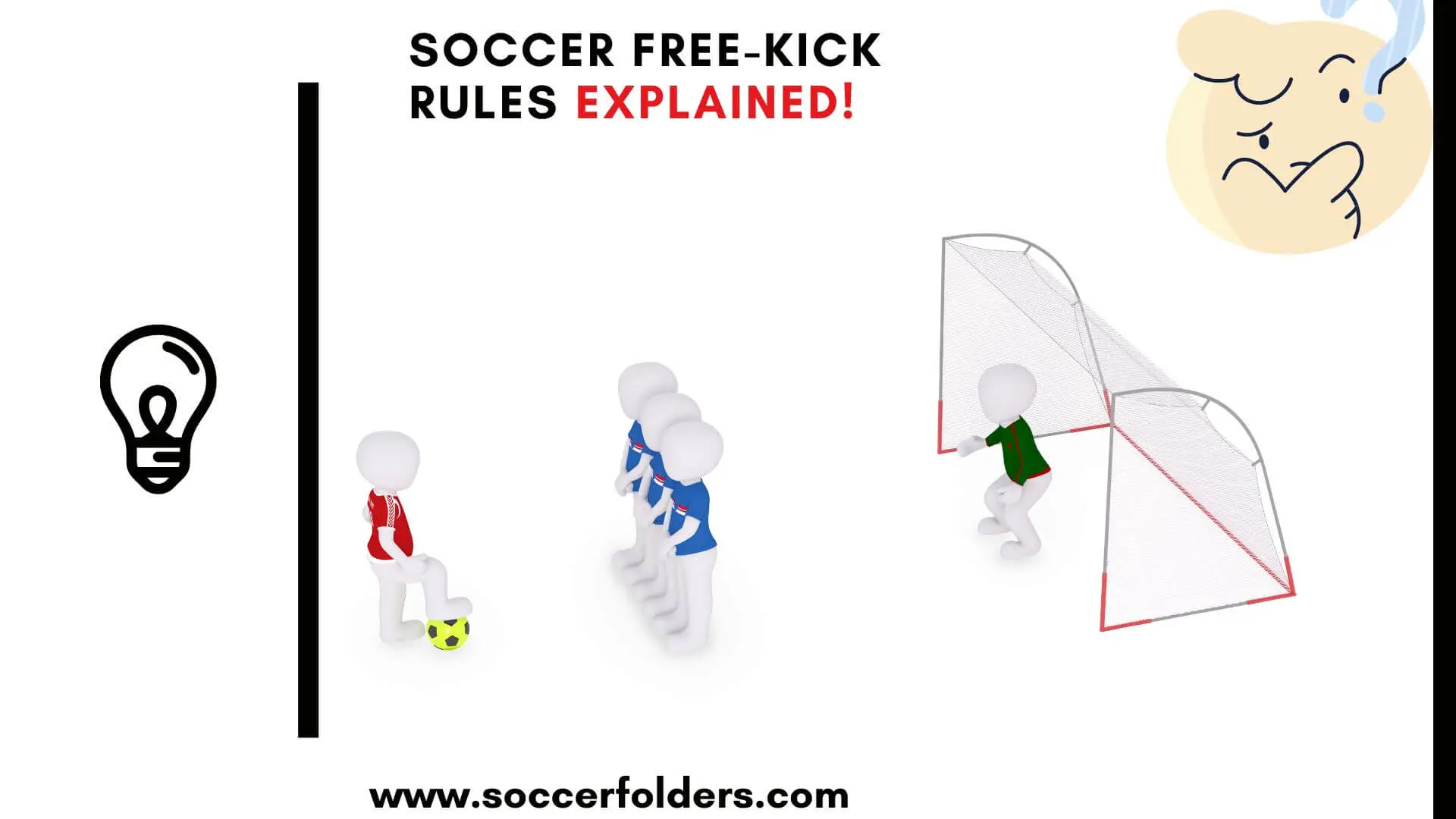As you lace up your boots and step onto the lush green field, a surge of adrenaline courses through your veins. The tension in the air is palpable as you stand over the ball, preparing for a free kick.
It’s a moment that can make or break a game, a shot at glory that can leave spectators on the edge of their seats.
Welcome to the art of mastering soccer Free Kick rules – an exhilarating journey that combines precision, technique, and a dash of finesse.
Table Of Contents
Understanding the Basics
Before we dive headfirst into the finer details of soccer free kick rules, let’s establish the groundwork.
A free kick is awarded to a team when an opponent commits a foul, typically within striking distance of the goal. There are two main types of free kicks: direct and indirect.
In a direct free kick, players can shoot directly at the goal, while an indirect free kick requires the ball to touch another player before a goal can be scored.
7 Soccer Free Kick Rules

- Direct vs. Indirect: Free kicks can be direct (score directly) or indirect (ball must touch another player before a goal).
- Whistle Signal: Wait for the referee’s whistle to start a free kick.
- Ball Position: Place the ball properly before taking the kick.
- Wall Distance: Defensive wall must be at least 10 yards (30 feet) away from the ball.
- Quick Free Kicks: You can also take advantage immediately after a foul, no need to wait for a separate signal.
- Referee Awareness: Inform your intent to your teammates and ensure the referee knows about the quick free kick.
- Foul Types: Free kicks can be awarded for fouls, offside, and dangerous play.
The Anatomy of the Perfect Free Kick
Picture this: you’re standing just outside the penalty area, the wall of defenders towering in front of you. Your heart pounds as you plot your course of action. To master the perfect free kick, consider these key factors:
- Technique: As you approach the ball, your technique is paramount. Keep your standing foot next to the ball and your eyes on the target. A slight backward lean can help with balance, setting the stage for a well-executed shot.
- Placement: Precision over power is the name of the game. Select your spot and visualize the ball sailing into the net. Whether it’s the top corner or just past the outstretched fingertips of the goalkeeper, aim with intent.
- Run-up: Your run-up should be purposeful and steady. It’s the runway to your masterpiece. Vary your pace, and just before striking, give that extra burst of energy to add a hint of unpredictability.
- Curve and Dip: Ever seen a ball swerve like a majestic eagle in flight? That’s the magic of curve. By striking the ball at a slight angle, you can make it bend around the wall, leaving the goalkeeper reaching for thin air. The dip adds an element of surprise, making the ball drop suddenly just before hitting the net.
Navigating the Wall
Ah, the formidable wall – a human shield determined to thwart your efforts. But fear not; there’s a psychology to breaking it down.
Subtle mind games, like adjusting the angle of your run-up at the last moment, can create doubt in the defenders’ minds.
They might wonder if you’re aiming for the other side, leaving gaps for your shot to sneak through.
Mind over Matter
As much as soccer Free Kick rules are about technique, they’re equally about mental strength.
The walk from the halfway line to the ball can feel like a marathon of doubt and second-guessing.
Embrace this uncertainty; it’s the chisel that carves champions. Keep a clear mind, focus on your practice, and don’t let the pressure overpower your passion.
A Glimpse into Greatness
As we examine the complexities of free kick regulations in soccer, we can take motivation from the icons who have made their mark in soccer history.
David Beckham, famous for his curved free kicks, was a master in manoeuvring the ball around obstacles and into the goal.
His commitment to refining his skills is a tribute to the creativity involved in every free kick.
Free kick Wall Distance from Ball

The distance between the free kick wall and the ball isn’t just a random number. It’s a strategic choice that can make or break a goalkeeper’s day.
As the attacker, you’d love to have a clear line of sight to the goal, but the wall, like a fortress, stands in your way.
On the flip side, defenders aim to block your view, minimize your shooting options, and shield their goalkeeper.
Getting the Right Measure
The official rules allow the defensive wall to be at least 9.15 meters (approximately 10 yards) away from the ball. Which is approximately 30 feet from the ball.
This distance provides a window of opportunity for skilled attackers to navigate their shots over or around the wall.
But here’s the intriguing twist – the referee often has to step in and ensure the wall is positioned correctly.
Sometimes, that 10-yard rule can feel like a negotiation, with players trying to inch forward while the referee keeps order.
You can read more on the IFAB.
Mind Games and Mindfulness
Have you ever wondered why free-kick takers meticulously place the ball before stepping back to measure the distance?
It’s not just for show; it’s a subtle tactic. The moment you place the ball, defenders instinctively react, shuffling to establish the wall.
Those precious seconds can be a mental mind game, allowing you to plan your next move and visualize your shot trajectory.
Bridging the Gap
Now, let’s talk strategy. If you’re the free kick taker, you might want to exploit the space behind the wall.
A ball played slightly higher can curve and dip just in time to sneak under the crossbar.
On the other hand, aiming for the side with fewer defenders might catch the goalkeeper off guard.

It’s all about outsmarting your opponents while making the most of the wall’s limitations.
Quick Free Kick Rules
To execute a quick free kick, keep a few key rules in mind.
- React to the Whistle: When the referee signals a foul, you can take a quick free kick without waiting for an additional signal.
- Stationary Ball: Ensure the ball is motionless before taking the quick free kick.
- Communication: Let your teammates know about your intent for a swift play to synchronize movements.
- Outsmarting Opponents: Capitalize on the element of surprise to catch opponents off balance and unprepared.
Tactical Brilliance
Quick free kicks are more than just spontaneous actions; they’re tactical decisions that demand awareness and precision.
Consider the positioning of your teammates and the opposition. Is there a gap in the defensive line that you can exploit? Are your teammates ready to receive a pass?
By assessing the situation swiftly, you can make split-second decisions that catch your opponents off guard.
Frequently Asked Questions About Soccer Free Kick Rules
Q1: What makes a free kick direct or indirect?
A free kick can be either direct or indirect, based on the intent and outcome. In a direct free kick, the player can score directly from the kick, meaning the ball can go straight into the goal without touching another player. An indirect free kick, on the other hand, requires the ball to touch another player before a goal can be scored.
This distinction adds an extra layer of strategy to the game, as players often use indirect free kicks to set up a play or pass before attempting a shot on goal.
Q2: Can a player take a free kick before the whistle?
No, a player cannot take a free kick before the referee blows the whistle. The whistle serves as a signal to start the play and ensures that both teams are ready for the kick. Attempting a free kick before the whistle is blown can result in a yellow card for the offending player and the kick being retaken.
Q3: When can free kicks be awarded in soccer?
Free kicks can be awarded for various infringements during a soccer match. These include fouls such as tripping, pushing, or handling the ball with the hands. The location of the free kick is determined by where the foul occurred.
Q4: Can you pass the ball to yourself on a free kick?
No, players can’t pass the ball to themselves during a free kick. Attempting to do so isn’t allowed as per the rules. While it might seem like a tactic to catch defenders off guard, regulations require the ball to be played from one player to another. The ball must clearly move and not be stationary when touched while ensuring no rule violations take place during the manoeuvre.
Q5: How far must a wall be from a free kick?
According to the official rules, the defensive wall must be at least 10 yards (approximately 9.15 meters) away from the ball during a free kick. This distance gives the attacking player space to aim for the goal or manoeuvre the ball around the wall. The referee often ensures that the wall is positioned correctly before allowing the kick to be taken.
Final Word
As the final whistle blows and you walk off the field, remember that the journey to mastering soccer free-kick rules is an ongoing one.
It’s about embracing the joy of practice, the thrill of the game, and the satisfaction of pushing your boundaries.
With technique as your brush and the field as your canvas, you have the power to create moments of magic that resonate far beyond the confines of the pitch.
So, next time you stand over that ball, channel your inner Beckham and let the world marvel at the masterpiece you’re about to unleash.
You can also read the rules of soccer simplified here.


